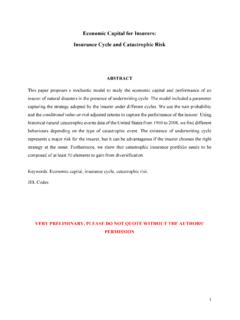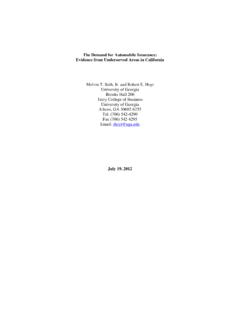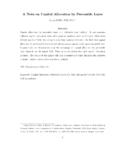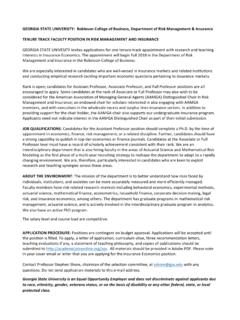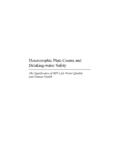Transcription of Risk Management in Retirement – What is the Optimal Home ...
1 Risk Management in Retirement What is the Optimal Home Equity Release product ? Katja Hanewald1, Thomas Post2 and Michael Sherris3. 15 July 2012. Draft prepared for the ARIA 2012 Annual Meeting Please do not cite or circulate without prior consent by the authors Abstract: This paper studies the Optimal choice of home equity release products. The decision problem of a retiring couple is modeled that holds the major fraction of their wealth as home equity and faces longevity, long-term care, house price, and interest rate risk. The couple can choose to buy annuities, long-term care insurance, and to borrow against the home using different equity release products. These decisions involve the timing problem of when to optimally release home equity. The framework is used to compare the welfare effects of different home equity release products and to study the role of government-provided long-term care insurance. JEL Classification: D14, D91, G11, R20.
2 Keywords: Retirement , inter-temporal optimization and decision making, home equity release, reverse mortgage, annuities, long-term care insurance 1 [Contact author] School of Risk and Actuarial and ARC Centre of Excellence in Population Ageing Research (CEPAR), Australian School of Business, University of New South Wales, Sydney, Australia. Email: 2 Department of Finance, School of Business and Economics, Maastricht University and Netspar, Email: 3 School of Risk and Actuarial Studies and ARC Centre of Excellence in Population Ageing Research (CEPAR), Australian School of Business, University of New South Wales. Email: 1. 1 Introduction This paper studies the Optimal product choice of home equity release products from the homeowner's perspective in the presence of longevity, long-term care, house price, and interest rate risk. A retiring couple chooses among different home equity release contracts, and long-term care and longevity insurance products.
3 Home equity release contracts differ substantially in the way house price risks are shared and transferred between the homeowner and the lender. Due to this the Optimal choice is strongly dependent on the homeowners' individual characteristics (including risk aversion and a bequest motive) and on the interaction with longevity and long- term care risks, which vary strongly between different institutional settings. Home equity is a very special asset class. The home is an investment and a residence, providing non-pecuniary services. For example, people value the ability to age in place (Davidoff, 2010c) and, even with substantial mortgage balances outstanding, people are happy about being a homeowner (Whitehead and Yates, 2010). Homeownership rates are high and are between 50%. and 80% for most OECD countries (Andrews and Caldera S nchez, 2011). Home equity represents the major share of the elderly's total assets. For example, for households aged 65+, in the , the value of the primary residence comprises on average (median) 49% (52%) of households' total assets, with 82% of households aged 65+ actually owning a house (2009 wave of the Survey of Consumer Finances).
4 A home is not an ideal asset to meet the financial needs of elderly households especially when having no other substantial sources of income. It concentrates a large amount of household savings in a single asset, exposing the household to substantial idiosyncratic risk (Case, Cotter, and Gabriel, 2011). It is illiquid, and in case of urgent 2. cash needs, for example, due to health shocks it cannot be sold in parts to pay for out-of-pocket costs. Home equity release products convert home equity into liquid wealth but allow homeowners to continue residing in their home. Markets for equity release products are growing in the (Shan, 2011), in the UK (KRS, 2011) and elsewhere (Reifner et al., 2009; Deloitte and SEQUAL, 2012). A range of different contract designs exist that share and transfer house price risks in various ways between the homeowner and the lender. The most common product in most markets is a reverse mortgage with rolled-up interest (Oliver Wyman, 2008; Davidoff 2010c).
5 This product allows homeowners to participate in house price appreciations, while giving protection to adverse house price developments through a no-negative equity guarantee (NNEG). typically embedded in the product . Home reversion schemes available, for example, in the UK. and in Australia allow homeowners to transfer a proportion of house price risks to the lender in exchange for a lump-sum payment and a lease-for-life agreement (Oliver Wyman, 2008). Contract designs also differ in other dimensions such as having a fixed or variable interest rate (Oliver Wyman, 2008). Markets are very dynamic and new products are being constantly developed (Australian Securities and Investment Commission, 2005). Comparing and choosing among various products with different risk and return features has become an increasingly important, but also increasingly difficult task for today's homeowners. Several papers examine home equity release products in Optimal household portfolios.
6 Artle and Varaiya (1978) show that the possibility of borrowing against home equity in Retirement and thereby relaxing liquidity constraints and smoothing consumption over the life cycle enhances 3. utility. Fratantoni (1999) models the product choice between two reverse mortgage designs . annuity payout plan and line-of-credit plan for an elderly homeowners facing non-insurable expenditure shocks. He finds that line-of-credit plans are generally preferable since they are more flexible and can provide large sums of money in case of the expenditure shock. Davidoff (2009, 2010a, 2010b) extends this research by allowing for health and longevity risks. He confirms that the availability of the reverse mortgages itself is utility-enhancing and finds interaction effects with annuities and long-term care insurance. For example, home equity may substitute long term care insurance. Davidoff (2010c) introduces house price risk into a reverse mortgage choice model.
7 He shows that amortization of interest (rolled-up interest), a feature inherent in many currently sold contracts types, is not always Pareto Optimal . Likewise, Yogo (2009) considers stochastic housing prices (and stochastic health depreciation), confirming that reverse mortgages are utility enhancing. The decision between fixed-rate and adjustable-rate products so far has been studied for normal mortgages, with adjustable-rate products being found more attractive to homeowners (Campbell and Cocco, 2003). In summary, a number of studies using different models find that reverse mortgages are utility- enhancing. The utility gains are shown to depend on the interaction with health and longevity risks, and on the availability of products to insure against these risks. This study provides the following contributions to the literature. First, we extend previous models by considering longevity, long-term care, house price, and interest rate risk and by modeling the household as a couple as reverse mortgage decisions are often triggered by the 4.
8 Death of one Second, a general model is developed covering a range of different equity release products and the timing problem of when to release home equity. Third, we analyze the Optimal choice in different institutional settings for long term care insurance (LTCI) and examine the resulting interactions. We distinguish between a setting in which most costs have to be paid out-of-pocket with private insurance available and a setting in which most long-term care costs are born by a government-sponsored system. The results of this study show that the couple enjoys large utility gains from having access to either one of the two equity release products. Higher utility gains are found for the reverse mortgage. The household chooses to unlock home equity early on in Retirement . These key results emerge consistently across a range of cases with different parameter values. The availability of a government-provided LTCI does not change the use of equity release products significantly, but does change the demand for annuities.
9 The paper is structured as follows. Section 2 introduces the life cycle model. Section 3 presents the results. Section 4 concludes and discusses policy recommendations. 1. Shan (2011) reports that 45% in the equity release program are single females, 34% are couples, and 11% are single males (based on 2007 data). In Australia, the majority of equity release customers are couples between 70-75. years old (Deloitte and SEQUAL, 2012). 5. 2 The Model General Structure of the Model and Timing The decision problem of a retiring couple is modeled that holds the major fraction of wealth in their home. The index , is used to denote probabilities, payouts or utility values of the husband (m) and the wife (f), respectively. The couple faces longevity risk, long-term care risk, house price risk, and interest rate risk. Different insurance and home equity release products are available to the couple. The decisions of the couple are modeled in an augmented life cycle model.
10 The model extends previous work by Davidoff (2009, 2010b, 2010c) by considering a couple, by allowing for interest rate risk, by including different types of equity release products and modeling the timing decision of when to release home equity. A two-period model (three points in time) is developed that captures the couple's decisions at Retirement and at an advanced age. The model's input parameters are calibrated such that each of the two periods reflects a multi-year horizon. Figure 1. illustrates the decision and timing structure of the model. -- Figure 1 here -- At time t = 0, both spouses are in good health. The initial endowment consists of the home and liquid wealth. The couple decides on consumption, on saving over the first period of their Retirement , on purchasing annuities, long-term care insurance (LTCI) and on taking out an equity release product . Equity release products increase liquid wealth available for consumption, saving, and for purchasing insurance products.



